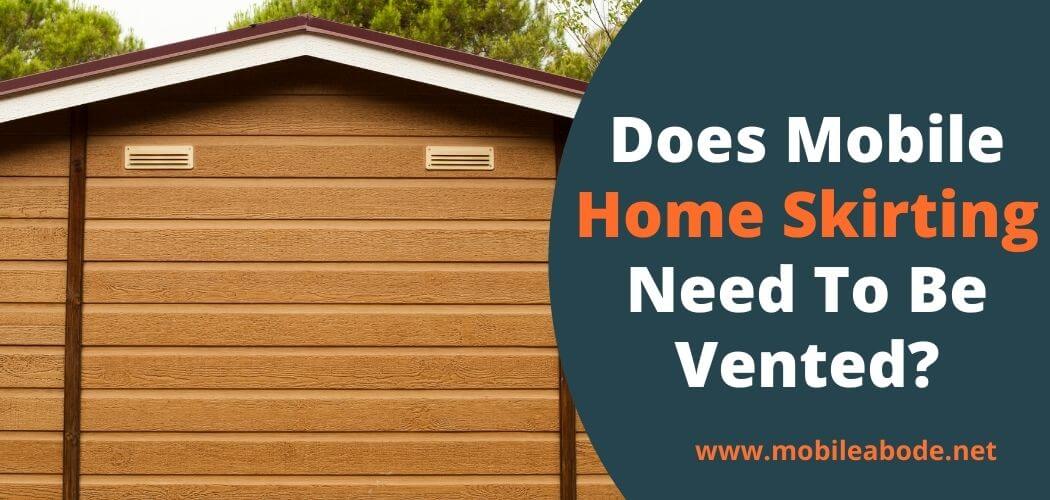Questions about mobile home skirting and proper ventilation are abundant. To ensure your home is safe and comfortable, it’s important to understand the basics of venting and how it applies to mobile homes.
I’ll answer the most common questions about venting for your convenience in this post.
Mobile Home Vents: Know What’s Under Your Skirting!
Mobile home vents are exactly what they sound like – ventilation systems that serve to protect the foundation of a mobile home from the elements.
This includes hot and cold air, rainwater, dust, leaves, etc. In some cases, skirting is even necessary if your lot is below grade or on a hillside since it can prevent flooding during heavy downpours.
Mobile home skirting has specific requirements depending on where you live as well as whether or not you have a crawl space underneath your home.
Does mobile home skirting need to be vented?
Many homeowners are surprised to learn that their mobile home needs to be vented. If you live in a place with cold winters, venting is essential.
Without proper venting, your gas lines can freeze and burst. This can cause all kinds of damage inside your home; not only will you have an urgent repair job on your hands but also won’t be able to use any appliances until they are fixed!
That means no heat or hot water for days or even weeks depending on how much damage there is.
Also Read: How To Keep Water From Running Under Mobile Home?
Not only that, but if the gas line does burst without proper ventilation it could spark an explosion which would leave everyone in the surrounding area at risk of injury or death!
It may seem like overkill to install vents when the temperatures drop below freezing, but it truly is a safety issue and one that should be taken seriously.
Whether you live in an area prone to cold temperatures or just want to prevent any accidents from happening, installing a proper mobile home vent is a worthwhile investment.
It’s well worth the cost in terms of convenience and peace of mind knowing your family won’t be in danger during the winter months.
What Certain Sites Are Saying About Mobile Home Vents: “A whole house fan is what many people use as their ventilation for their home since they situate them inside their homes usually near or under living areas.
How many vents should a mobile home skirting be?
So how many vents should your mobile home skirting be? This will depend on the type of home you have and other factors.
When in doubt, more is better than less!
More vents mean that you’re giving your mobile home some options when it comes to where hot air can escape. It also allows cold air to get into the space between the foundation (skirting) and the ground.
At least one vent should be put near each corner of your home for maximum coverage. But if you want to make sure no cold pockets form between your skirting and foundation, it’s a good idea to install two vents at opposite corners on each side of the house (a total of 8).
This also ensures that your vents are both placed in optimal locations for getting cold air out and hot air in.
Must Check: Mobile Home Skirting Calculator
**NOTE: If you have a crawl space under your mobile home, it needs to be vented too!
How do you vent a mobile home?
To vent your mobile home, you need to first look at your skirting. If it’s solid on all sides, you may want to consult a professional.
But if it doesn’t have any openings near the bottom on both sides of your home, reach under and make some!
You must follow proper construction practices when making these new vents.
For example, try not to puncture through anything other than the metal skirting itself along with using masonry bits rather than power tools for drilling into concrete or cinder blocks.
This will help ensure that rodents are less inclined to seek shelter in those areas as well as prevent unwanted chemicals from seeping into the space under your home.
If there are any existing vents or other holes in your skirting, make sure they’re all patched up before you start.
- Using a reciprocating saw with a metal blade, cut two openings on each side of your mobile home (at least one for every corner). The size of these vents will depend on the type of fan you purchase.
- Once they are cut to size, install the fans by attaching them to the inside wall near where it meets the foundation using either screws or sheet-metal screws.
- Be sure to stay as close as possible to that wall when drilling into it so that the final installation is as flush as possible. Next, run plastic tubing from each vent hole out through those areas along the bottom of your skirting.
- Connect the other end of this tubing to a PVC pipe that will be used as an intake for your fan by inserting one end into the other and sealing it with glue or tape. Finally, run a piece of metal wire from each PVC pipe to the fan so that you can secure them without wires showing on the outside of your home.
- Ideally, these should all come together at a single point which you can attach to your fan using hose clamps or zip ties.
If everything is done properly, you should have created a system in which cold air gets sucked through those new vents underneath your mobile home and expelled out of either side via an exhaust fan installed inside!
How do you keep moisture out of a mobile home?
You’ll want to make sure that moisture is kept out of your mobile home since it can lead to the growth of mold and mildew especially if you don’t have adequate ventilation.
This means replacing any damaged or missing skirting with new panels and keeping those vents clear of debris at all times.
You should also periodically check them for rodent activity since rodents like to build nests in such spots (inside the tubing itself). Then, keep sunlight from shining directly on your skirting using landscaping fabric or wooden stakes.
This will help ensure that heat doesn’t get trapped under there causing moisture buildup throughout the day.
Related Article: How Can I Get Rid Of Dampness And Mold In My Mobile Home?
If you follow these simple steps, you should be able to properly vent and de-humidify your mobile home just as efficiently as a traditional house. This will help ensure that your family stays safe and healthy while living in it!
Foundation vents should be installed on the exterior of the foundation at ground level or below. Vents cannot penetrate brick, block or masonry siding, stucco exteriors without proper caulk to seal out moisture intrusion into walls and floors.
Caution: Foundation vents may create a draft that can pull heated air from inside the home through inadequately insulated return-air ductwork or recirculate attic air into occupied areas.
Closing Remarks
If you are considering mobile home skirting for your property, be sure to consult with a professional before installation.
It is important that the unit is properly ventilated or it can pose a fire hazard.

